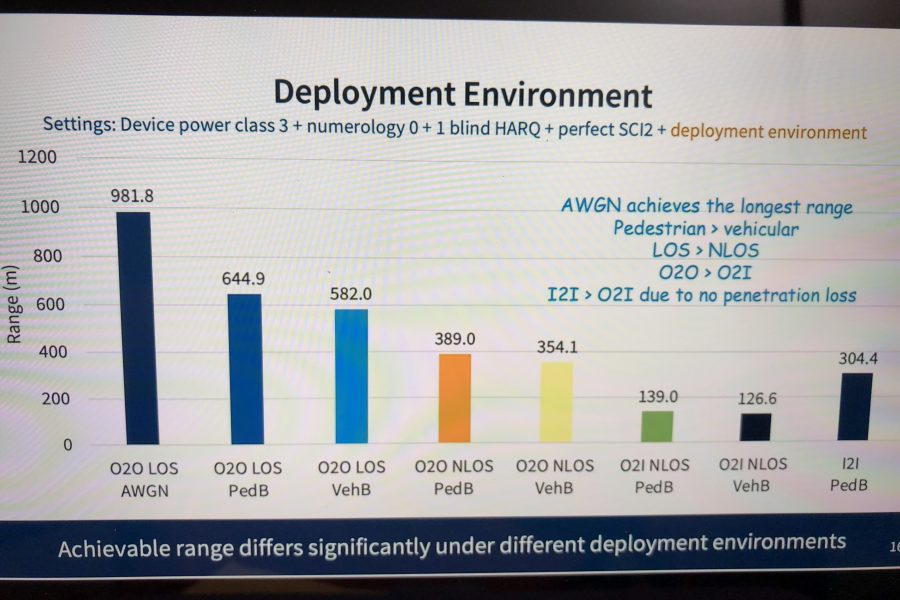Projected 5G device-to-device range falls short of LMR performance, simulator says
Device-to-device communications in 5G—known as sidelink—promise to provide new flexibility and functionality, but its potential range is expected to pale in comparison to the land-mobile-radio (LMR) direct-mode offerings used by public-safety responders today, according to National Institute of Standards and Technology (NIST) research.
Chunmei Liu, a researcher in the Wireless Networks Division of the Communications Technology Laboratory (CTL) at NIST, said that 5G New Radio (NR) sidelink is projected to support device-to-device communications at a maximum distance of 981.8 meters—slightly less than 5/8ths of a mile—in an “idealistic” scenario outdoors with line of sight, based on simulation research (graph pictured above). More realistic scenarios in the research indicate a device-to-device range of 644.9 meters (705.3 yards) for a pedestrian user and 582.0 meters (636.5 yards) for a user inside a vehicle.
These baseline projected figures indicate that 5G NR sidelink would provide similar range to the proximity services (ProSe) functionality in LTE. ProSe largely has been abandoned as a technology, with Samsung developing the only commercially available ProSe device that supported a range of “maybe half a mile,” according to a Samsung official.
Liu noted that 5G NR sidelink provides several options that can be used to extend the device-to-device range, such as increasing the number of transmissions to ensure that the signal is received. This technique can increase the range by as much as 70%, but it also results in increased latency and decreased data throughput to levels that can make many applications unusable for a first responder, she said.
“Our preliminary results show that 5G sidelink has the potential to increase range significantly … and there are some major factors that impact ranges, such as deployment environment, device power class, numerology, and HARQ configurations,” Liu said during a recorded presentation for the recent PSCR 2022 Broadband Stakeholders Meeting.
“Our results also show that increasing range comes with cost, and a careful design is required to balance range and other service requirements.”
Liu said that one way to increase the device-to-device communications range without degrading performance is to leverage high-power user equipment (HPUE), which can transmit signal at 1.25 watts—more than six times the normal 0.2 watts of a normal handheld cellular device. With HPUE operating on the 700 MHz Band 14 spectrum licensed to the FirstNet Authority, the device-to-device range is increased by more than 50%, resulting in the “idealistic” scenario delivering a range of 1,554.4 meters, or almost one mile.
But even this HPUE range represents a significant decrease in range when compared to the device-to-device communications supported by LMR devices, which can utilizes 3 watts to 5 watts of power to send signals. In addition to the extra power, LMR often operates on spectrum that provides much better signal propagation, and an LMR device often has an external antenna, as opposed to the internal antennas found in most LTE handsets.
Meanwhile, the projected 5G sidelink range is significantly decreased in scenarios in which the devices are not outdoors with a clear line of sight between them, according to the unique simulation research, Liu said.
“To our knowledge, our simulator is the first 5G sidelink link-level simulator developed,” Liu said. “We’re in the process of documenting it and plan to release it for public usage.”
In non-line-of-sight (NLOS) scenarios outdoors, the device-to-device range is expected to be 389.0 meters (425.4 yards) for pedestrian users, while the same scenario will yield a device-to-device range of 354.1 meters (387.2 yards) for users inside of vehicles, according to the simulator research.
Indoors, the maximum projected range is 304.4 meters (332.9 yards), but this assumes a line-of-sight (LOS) scenario Liu said. Impediments like walls will decrease the indoor device-to-device performance, but exactly how much will depend on a number of factors, including the materials used in the structure.
The most difficult scenario modeled by the simulator was device-to-device communications in which one user is outdoors and the other is indoors. In this outdoor-to-indoor (O2I) scenario, the range is projected to be 139.0 meters (152.0 yards) between pedestrian users and 126.6 meters (138.5 yards) between users in vehicles.
Many industry sources contend that such limitations in device-to-device communications via LTE or 5G is a major factor in major public-safety agencies being reluctant to transition mission-critical voice communications from LMR to broadband-wireless solutions. After all, first responders often need to communicate when commercial cellular services are unavailable, because the system is down or because they are operating outside of the terrestrial network’s coverage footprint.
However, with the availability of coverage-extension technologies like HPUE and “bring the network with you” deployable solutions—from pelican-case form factors to the Compact Rapid Deployable (CRD) asset that agencies can own—some question how often first responders will need device-to-device communications in the future.
Another potential factor that could impact this discussion is the development of companies like Lynk Global and AST SpaceMobile, which plan to deliver connectivity from a LEO-satellite-supported “LTE tower in space” directly to unmodified smart devices outside of a carrier’s terrestrial coverage footprint. Both companies expect to provide global service by 2025.


















My experience is the “real world” results will be worse than what is indicated by the simulators. When body position, terrain, trees, etc. are factored in the actual range is almost always less. This is also a factor with traditional LMR.
I believe the only real solution to the blend of network based and simplex communications is a combination of a cellular and LMR device in a single device. There are several manufacturers of these devices now. For example, having a radio with both LTE and VHF allows the radio user to use the LTE network where there is coverage but they can switch off the LTE network to a VHF network for wildland fires, larger area operations outside the LTE network coverage, and mutual aid with agencies who are not using LTE for their voice operations.
The LMR side of the system could be VHF, UHF, or 700/800 MHz. This allows for the different technologies and frequency bands to be used where they are optimum
It’s a bit crazy to be stating RF propagation distances to 4 significant digits. The numbers quoted are from a model and thus theoretical; I suppose there are some who insist on reading a bunch of non-significant digits from the calculator. Antenna proximity to the body, orientation, proximity to other absorbers, the actual NLOS and LOS paths, and the moment to moment temporal variation of those factors make for tremendous differences in path loss.
“Many industry sources contend that such limitations in device-to-device communications via LTE or 5G is a major factor in major public-safety agencies being reluctant to transition mission-critical voice communications from LMR to broadband-wireless solutions.”
This is absolutely the case for fire service users! We have to be able to communicate from the basement of a heavily constructed building to other users both inside and outside the hazard zone. Although we can operate “on network” the ability to manually switch to a reliable simplex channel is a major necessity to maintain constant communication. I can’t believe anyone involved was surprised by the results, given the frequency bands being used and the “flea power” being transmitted by these devices with no external antennas. I agree with the previous post, in that a hybrid LMR/LTE device will be needed.
Did anyone thought about a multi-hop sidelink communication method to increase range dramatically?